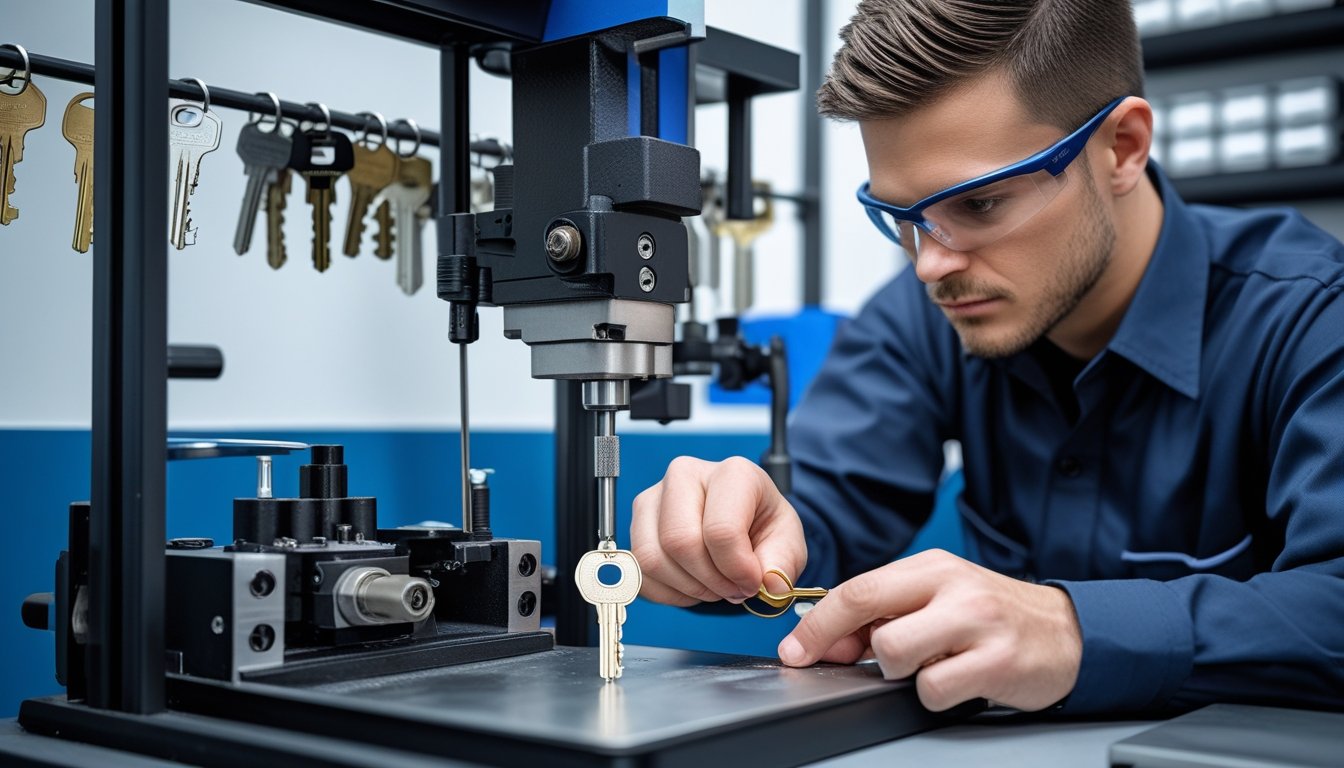Late updated: 28 Aug 2025 12:08
Written by: Elena Prescott
Understanding Key Duplication Processes: A Comprehensive Guide
Key duplication is an essential service, offering both convenience and security to individuals and businesses alike. From providing spare keys for emergencies to ensuring access for multiple family members or employees, its importance cannot be understated. At its core, key duplication involves crafting an exact replica of an existing key using precise techniques and machinery, ensuring it works seamlessly with the intended lock.

Understanding the nuances of key duplication involves exploring various methods ranging from traditional cutting machines to advanced, high-security techniques. Each offers unique benefits and is suited to specific needs, whether it’s for a simple house key or a more complex master key system. As technology evolves, so do the methods of duplication, offering enhanced security features and increased reliability.
It's vital that we also recognise the potential risks involved in indiscriminate key duplication, such as unauthorised access or security violations. This underscores the necessity of choosing trusted professionals who can provide high-quality duplicates while maintaining stringent security standards. As we delve into the intricacies of key duplication, we'll uncover the processes involved, the significance of selecting the right professionals, and answer some of the most common questions concerning this service.
Key Takeaways
- Key duplication creates an exact replica of an existing key.
- Various methods exist, from traditional to high-tech, each with unique benefits.
- Professional quality and security are crucial to avoid risks.
Key Duplication Processes and Mechanisms
In the realm of key duplication, understanding the intricacies involved is essential for both security professionals and everyday users. We will explore the different methods of duplication, the types of keys available, and address the legal and ethical concerns related to copying keys.
Methods of Key Duplication
Key duplication involves several techniques, each tailored to specific needs and levels of intricacy. Traditional methods include manual key cutting using a key duplicating machine. These machines replicate keys by cutting a blank to match an existing key's profile.
Advanced techniques utilise digital key cutting, where a key is scanned, and its image is used to mill a precise duplicate using computerised machines. Moreover, code cutting involves duplicating a key based on the original key's code, common with vehicle keys, where cutting follows a manufacturer's code.
Types of Keys and Access Restrictions
The world of keys is diverse, ranging from simple household keys to complex security keys. Standard keys include common household and padlock keys, which are easily duplicated. Restricted or patented keys have legal restrictions on duplication, designed to prevent unauthorized copying.
These keys often require distributor approval for duplication. Security keys, encompassing high-security and master keys, utilise patents and unique design elements to enhance security, making them difficult to duplicate without specific permissions or tools.
Legal and Ethical Aspects of Key Copying
Legal considerations play a crucial role in key duplication. Copy protection laws often govern the duplication of patented keys, with serious penalties for unauthorized replication. Ethical considerations are equally important, as duplicating keys without permission can breach trust and privacy.
Service providers, such as locksmiths, adhere to codes of conduct to balance customer needs and security requirements. When dealing with restricted or high-security keys, both legal compliance and ethical responsibility are paramount to maintaining societal trust and personal security.
Evolutionary Perspectives on Duplication

Gene duplication is a cornerstone of evolutionary biology, offering a mechanism for biological innovation and diversity. Whole-genome duplication events contribute significantly to the adaptation and evolution of various organisms. Understanding the regulatory relationships and network motifs in genes reveals crucial insights into evolutionary processes.
Gene Duplication and Biological Innovation
Gene duplication provides an opportunity for biological innovation by offering raw genetic material that can evolve new functions. With an extra copy of a gene, one can maintain its original role while the other undergoes mutations, potentially acquiring novel functions. Over time, this can lead to the development of new traits that confer evolutionary advantages.
Duplicated genes may become specialised for certain tasks, enhancing an organism’s ability to adapt to different environmental conditions. This innovation can lead to increased complexity and diversity in biological systems. Significantly, studying model organisms such as yeast helps us understand the pathways through which gene duplication impacts evolutionary dynamics.
Whole-Genome Duplication in Evolution
Whole-genome duplication (WGD) is a dramatic evolutionary event in which an entire set of genetic material is duplicated. It occurs less frequently than individual gene duplication but can have profound long-term effects on species. For example, plants like wheat and certain fish species have undergone WGD, which enabled them to develop unique adaptations.
Through WGD, organisms gain a surplus of genetic material that can diversify through mutations without compromising existing functions. These duplications can lead to increased biodiversity by providing a genetic canvas for natural selection to shape. The occurrence of WGD in evolutionary history is a critical factor in exploring the adaptation and origins of complex traits.
Regulatory Relationships and Network Motifs
Understanding regulatory relationships is essential to grasp how gene duplication shapes evolutionary processes. When gene duplication occurs, the duplicated genes often remain connected within genetic networks, influencing each other's function and organisation. The way these duplicated genes interact within network motifs can either stabilise genetic functions or lead to new regulatory pathways.
Studying these interactions reveals complexities within biological systems, showing how genetic redundancy can enable the rise of new regulatory roles. These regulatory relationships are crucial for deciphering how genetic networks evolve over time, and how they contribute to an organism's survival and adaptability. As we continue to map these networks, we gain invaluable insights into the intricacy of evolutionary mechanisms driven by duplication.
Frequently Asked Questions

Keys and their duplication processes have evolved significantly over time. From their design intricacies to modern management strategies, understanding these elements can enhance our knowledge of the essential systems that secure our environments.
What are the different components of a physical key?
A physical key typically comprises the bow (the part held), the blade (which inserts into the lock), and the cuts or bittings along the blade. These cuts match the lock's pins or wafers, allowing the key to turn and unlock the lock if the pattern aligns correctly.
How has the design of keys evolved over time?
The design of keys has transitioned from simple wooden devices in ancient times to sophisticated mechanisms made of durable metals. Innovations like the introduction of warded, tubular, and double-sided keys reflect advancements in security demands, tailoring designs to enhance both functionality and protection.
Can you explain the mechanism of a lock and key system?
A lock and key system functions through mechanical alignment. When a correctly cut key blade is inserted into a lock, the cuts on the key align the lock's internal pins, wafers, or discs to a shear line. This alignment permits the lock barrel to rotate, thus allowing access or securing the lock.
What are some interesting facts about keys and their development?
Keys once symbolised power and authority, often worn as jewellery by the elite in ancient cultures. As societies progressed, keys became more accessible. The advent of modern locksmithing significantly increased the variety and complexity of key designs, making unauthorised duplication more challenging than ever before.
What strategies are used for effective key management in organisations?
Effective key management in organisations includes maintaining detailed inventories, employing key control software, and ensuring secure storage. Procedures for issuing and returning keys are crucial. Regular audits and training also play significant roles, all aimed at minimising risks associated with unauthorised duplication or loss.
What are the various types of keys used in locks and security systems today?
Today’s security systems utilise an array of keys, including skeleton keys, tubular keys, paracentric keys, and dimple keys. High-security systems may employ restricted keys, which require authorisation for duplication. Additionally, electronic and digital keys are increasingly prevalent, offering enhanced security features through biometrics or encryption.
